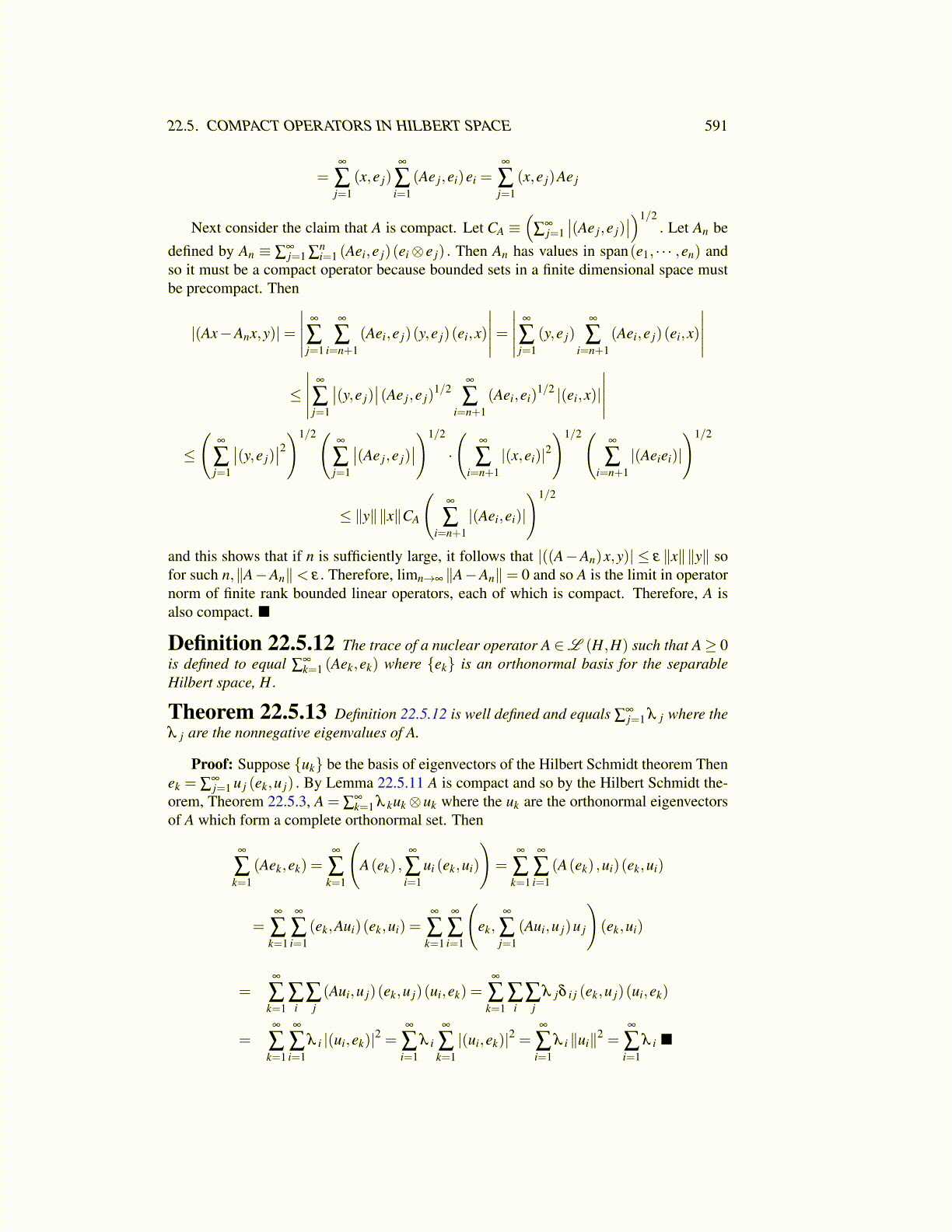
22.5. COMPACT OPERATORS IN HILBERT SPACE 591
=∞
∑j=1
(x,e j)∞
∑i=1
(Ae j,ei)ei =∞
∑j=1
(x,e j)Ae j
Next consider the claim that A is compact. Let CA ≡(
∑∞j=1∣∣(Ae j,e j)
∣∣)1/2. Let An be
defined by An ≡ ∑∞j=1 ∑
ni=1 (Aei,e j)(ei⊗ e j) . Then An has values in span(e1, · · · ,en) and
so it must be a compact operator because bounded sets in a finite dimensional space mustbe precompact. Then
|(Ax−Anx,y)|=
∣∣∣∣∣ ∞
∑j=1
∞
∑i=n+1
(Aei,e j)(y,e j)(ei,x)
∣∣∣∣∣=∣∣∣∣∣ ∞
∑j=1
(y,e j)∞
∑i=n+1
(Aei,e j)(ei,x)
∣∣∣∣∣≤
∣∣∣∣∣ ∞
∑j=1
∣∣(y,e j)∣∣(Ae j,e j)
1/2∞
∑i=n+1
(Aei,ei)1/2 |(ei,x)|
∣∣∣∣∣≤
(∞
∑j=1
∣∣(y,e j)∣∣2)1/2(
∞
∑j=1
∣∣(Ae j,e j)∣∣)1/2
·
(∞
∑i=n+1
|(x,ei)|2)1/2(
∞
∑i=n+1
|(Aeiei)|)1/2
≤ ∥y∥∥x∥CA
(∞
∑i=n+1
|(Aei,ei)|)1/2
and this shows that if n is sufficiently large, it follows that |((A−An)x,y)| ≤ ε ∥x∥∥y∥ sofor such n,∥A−An∥< ε. Therefore, limn→∞ ∥A−An∥= 0 and so A is the limit in operatornorm of finite rank bounded linear operators, each of which is compact. Therefore, A isalso compact. ■
Definition 22.5.12 The trace of a nuclear operator A ∈L (H,H) such that A≥ 0is defined to equal ∑
∞k=1 (Aek,ek) where {ek} is an orthonormal basis for the separable
Hilbert space, H.
Theorem 22.5.13 Definition 22.5.12 is well defined and equals ∑∞j=1 λ j where the
λ j are the nonnegative eigenvalues of A.
Proof: Suppose {uk} be the basis of eigenvectors of the Hilbert Schmidt theorem Thenek = ∑
∞j=1 u j (ek,u j) . By Lemma 22.5.11 A is compact and so by the Hilbert Schmidt the-
orem, Theorem 22.5.3, A = ∑∞k=1 λ kuk⊗uk where the uk are the orthonormal eigenvectors
of A which form a complete orthonormal set. Then
∞
∑k=1
(Aek,ek) =∞
∑k=1
(A(ek) ,
∞
∑i=1
ui (ek,ui)
)=
∞
∑k=1
∞
∑i=1
(A(ek) ,ui)(ek,ui)
=∞
∑k=1
∞
∑i=1
(ek,Aui)(ek,ui) =∞
∑k=1
∞
∑i=1
(ek,
∞
∑j=1
(Aui,u j)u j
)(ek,ui)
=∞
∑k=1
∑i
∑j(Aui,u j)(ek,u j)(ui,ek) =
∞
∑k=1
∑i
∑j
λ jδ i j (ek,u j)(ui,ek)
=∞
∑k=1
∞
∑i=1
λ i |(ui,ek)|2 =∞
∑i=1
λ i
∞
∑k=1|(ui,ek)|2 =
∞
∑i=1
λ i ∥ui∥2 =∞
∑i=1
λ i ■